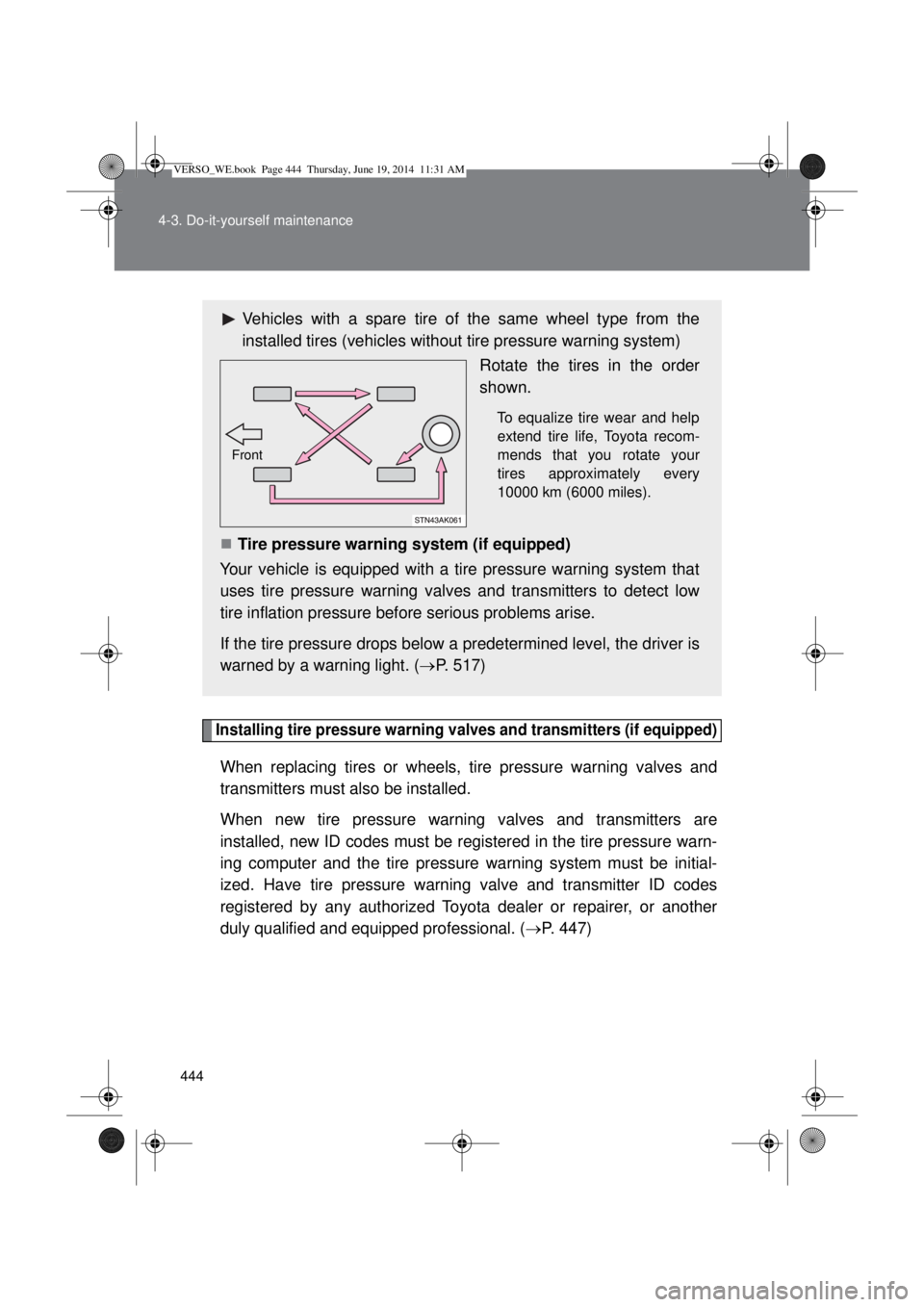Page 410 of 650

410 4-2. Maintenance
Where to go for maintenance service?
In order to maintain your vehicle in the highest possible condition, Toyota
recommends that maintenance service operations as well as other inspec-
tions and repairs be carried out by authorized Toyota dealers or repairers or
other duly qualified and equipped professionals. For repairs and services
covered by your warranty, please visit an authorized Toyota dealer or
repairer, who will use genuine Toyota parts in repairing any difficulties you
may encounter. There can also be advantages in utilizing authorized Toyota
dealers or repairers for non-warranty repairs and services, as members of
the Toyota network will be able to expertly assist you with any difficulties you
may encounter.
Your Toyota dealer or repairer, or another duly qualified and equipped pro-
fessional service department will perform all of the scheduled maintenance
on your vehicle-reliably and economically due to their experience with
Toyota vehicles.
Does your vehicle need repair?
Be on the alert for changes in performance and sounds, and visual tip-offs
that indicate service is needed. Some important clues are:
Engine misfire, stumbling, or pinging
Appreciable loss of power
Strange engine noises
A fluid leak under the vehicle (However, water dripping from the air condi-
tioning after use is normal.)
Change in exhaust sound (This may indicate a dangerous carbon mon-
oxide leak. Drive with the windows open and have the exhaust system
checked immediately.)
Flat-looking tires, excessive tire squeal when cornering, uneven tire wear
Vehicle pulls to one side when driving straight on a level road
Strange noises related to suspension movement
Loss of brake effectiveness, spongy feeling brake pedal, pedal almost
touches the floor, vehicle pulls to one side when braking
VERSO_WE.book Page 410 Thursday, June 19, 2014 11:31 AM
Page 413 of 650
413 4-3. Do-it-yourself maintenance
4
Maintenance and care
ItemsParts and tools
Engine oil levelP. 424)
1ZR-FAE, 2ZR-FAE, 1AD-FTV
and 2AD-FHV engines
• “Toyota Genuine Motor Oil” or
equivalent
• Rag or paper towel, funnel
(used only for adding oil)
1WW-FHV engine
• “Toyota Genuine Motor Oil
5W-30 Premium Fuel Economy
for 1WW/2WW engines”
• Rag or paper towel, funnel
(used only for adding oil)
Fuses (P. 469)• Fuse with same amperage rating
as original
Radiator, condenser and inter-
cooler (P. 433)
Tire inflation pressure (P. 457)• Tire pressure gauge
• Compressed air source
Washer fluid (P. 438)• Water washer fluid containing
antifreeze (for winter use)
VERSO_WE.book Page 413 Thursday, June 19, 2014 11:31 AM
Page 443 of 650
443
4-3. Do-it-yourself maintenance
4
Maintenance and care
Tires
Replace the tires when the treadwear indicators show.
Checking tires
New tread
Treadwear indicator
Worn tread
The location of treadwear indi-
cators is shown by the “TWI” or
“ ” marks, etc., molded on
the sidewall of each tire.
Check spare tire condition and
inflation pressure if not rotated.
Tire rotation
Vehicles with a spare tire of different wheel type from the
installed tires or an emergency tire puncture repair kit (vehicles
with or without tire pressure warning system); or Vehicles with a
spare tire of the same wheel type from the installed tires (vehi-
cles with tire pressure warning system)
Rotate the tires in the order
shown.
To equalize tire wear and help
extend tire life, Toyota recom-
mends that you rotate your
tires approximately every
10000 km (6000 miles).
Front
VERSO_WE.book Page 443 Thursday, June 19, 2014 11:31 AM
Page 444 of 650

444 4-3. Do-it-yourself maintenance
Installing tire pressure warning valves and transmitters (if equipped)
When replacing tires or wheels, tire pressure warning valves and
transmitters must also be installed.
When new tire pressure warning valves and transmitters are
installed, new ID codes must be registered in the tire pressure warn-
ing computer and the tire pressure warning system must be initial-
ized. Have tire pressure warning valve and transmitter ID codes
registered by any authorized Toyota dealer or repairer, or another
duly qualified and equipped professional. (P. 447)
Vehicles with a spare tire of the same wheel type from the
installed tires (vehicles without tire pressure warning system)
Rotate the tires in the order
shown.
To equalize tire wear and help
extend tire life, Toyota recom-
mends that you rotate your
tires approximately every
10000 km (6000 miles).
Tire pressure warning system (if equipped)
Your vehicle is equipped with a tire pressure warning system that
uses tire pressure warning valves and transmitters to detect low
tire inflation pressure before serious problems arise.
If the tire pressure drops below a predetermined level, the driver is
warned by a warning light. (P. 517)
Front
VERSO_WE.book Page 444 Thursday, June 19, 2014 11:31 AM
Page 445 of 650

445 4-3. Do-it-yourself maintenance
4
Maintenance and care
Initializing the tire pressure warning system (if equipped)
The tire pressure warning system must be initialized in the fol-
lowing circumstances:
When rotating front and rear tires which have different tire infla-
tion pressures
When the tire inflation pressure is changed such as when
changing traveling speed
When changing the tire size
When the tire pressure warning system is initialized, the current
tire inflation pressure is set as the benchmark pressure.
How to initialize the tire pressure warning system (if
equipped)
Park the vehicle in a safe place and turn the engine switch to
the “LOCK” position (vehicles without smart entry & start sys-
tem) or the “ENGINE START STOP” switch off (vehicles with
smart entry & start system).
Initialization cannot be performed while the vehicle is moving.
Adjust the tire inflation pressure to the specified cold tire infla-
tion pressure level. (P. 621)
Make sure to adjust the tire pressure to the specified cold tire infla-
tion pressure level. The tire pressure warning system will operate
based on this pressure level.
Turn the engine switch to the “ON” position (vehicles without
smart entry & start system) or the “ENGINE START STOP”
switch to IGNITION ON mode (vehicles with smart entry &
start system).
VERSO_WE.book Page 445 Thursday, June 19, 2014 11:31 AM
Page 447 of 650

447 4-3. Do-it-yourself maintenance
4
Maintenance and care
Registering ID codes (vehicles with the tire pressure warning system)
The tire pressure warning valve and transmitter is equipped with a
unique ID code. When replacing a tire pressure warning valve and
transmitter, it is necessary to register the ID code. Have the ID code
registered by any authorized Toyota dealer or repairer, or another
duly qualified and equipped professional.
When to replace your vehicle’s tires
Tires should be replaced if:
You have tire damage such as cuts, splits, cracks deep enough to
expose the fabric or bulges indicating internal damage
A tire goes flat repeatedly or cannot be properly repaired due to the size
or location of a cut or other damage
If you are not sure, consult with any authorized Toyota dealer or repairer, or
another duly qualified and equipped professional.
Replacing tire and wheels (vehicles with the tire pressure warning sys-
tem)
If the ID code of the tire pressure warning valve and transmitter is not regis-
tered, the tire pressure warning system will not work properly. After driving
for about 10 minutes, the tire pressure warning light blinks for 1 minute and
stays on to indicate a system malfunction.
Tire life
Any tires over 6 years old must be checked by a qualified technician even if
they have seldom or never been used or damage is not obvious.
VERSO_WE.book Page 447 Thursday, June 19, 2014 11:31 AM
Page 448 of 650

448 4-3. Do-it-yourself maintenance
Routine tire inflation pressure checks (vehicles with the tire pressure
warning system)
The tire pressure warning system does not replace routine tire inflation pres-
sure checks. Make sure to check tire inflation pressure as part of your rou-
tine of daily vehicle checks.
Initializing the tire pressure warning system (if equipped)
Initialize the system with the tire inflation pressure adjusted to the specified
level.
If the tread depth wears down to 4 mm (0.16 in.) or more on snow tires
The effectiveness of snow tires is lost.
When initialization of the tire pressure warning system has failed (if
equipped)
Initialization can be completed in a few minutes. However, in the following
cases, the settings have not been recorded and the system will not operate
properly. If repeated attempts to record tire inflation pressure settings are
unsuccessful, have the vehicle inspected by any authorized Toyota dealer or
repairer, or another duly qualified and equipped professional.
When operating the tire pressure warning reset switch, the tire pressure
warning light does not blink 3 times.
After driving for a certain period of time since the initialization has been
completed, the warning light comes on after blinking for 1 minute.
VERSO_WE.book Page 448 Thursday, June 19, 2014 11:31 AM
Page 455 of 650

455 4-3. Do-it-yourself maintenance
4
Maintenance and care
CAUTION
When inspecting or replacing tires
Observe the following precautions to prevent accidents.
Failure to do so may cause damage to parts of the drive train, as well as
dangerous handling characteristics, which may lead to an accident resulting
in death or serious injury.
Do not mix tires of different makes, models or tread patterns.
Also, do not mix tires of remarkably different treadwear.
Do not use tire sizes other than those recommended by Toyota.
Do not mix differently constructed tires (radial, bias-belted or bias-ply
tires).
Do not mix summer, all season and winter tires.
Do not use tires that have been used on another vehicle.
Do not use tires if you do not know how they were used previously.
When initializing the tire pressure warning system (if equipped)
Do not operate the tire pressure warning reset switch without first adjusting
the tire inflation pressure to the specified level. Otherwise, the tire pressure
warning light may not come on even if the tire inflation pressure is low, or it
may come on when the tire inflation pressure is actually normal.
VERSO_WE.book Page 455 Thursday, June 19, 2014 11:31 AM